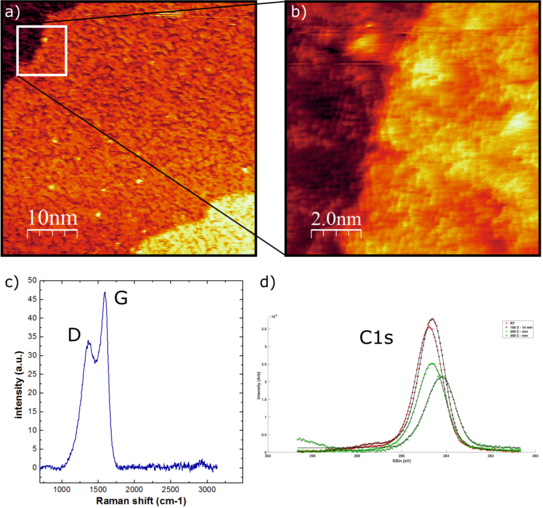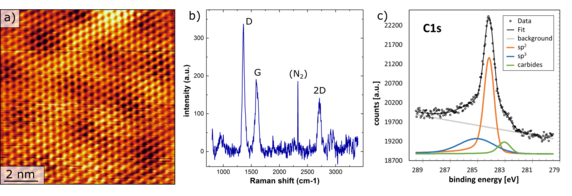Under GRANN we aim to bring our knowledge and expertise with graphene synthesis, graphene coatings and control of graphenes’ electronic properties on macroscopic samples into the realm of nanoparticles and nano-grains. We will exploit the remarkable properties of graphene by designing and synthesizing a new family of high quality monolayer graphene coated metal nanoparticles and by chemically functionalizing these graphene coated nanoparticles to tune their chemical and electronic properties. Furthermore, we will synthesize graphene coated SiC nano-grains - an ideal model system for interstellar dust grains – and explore their catalytic activity in key interstellar reactions under a range of interstellar conditions.
This will allow us to address a series of questions of both fundamental scientific nature and of relevance to industrial applications. Specific questions that we will address include: Can we protect metallic nanoparticles from oxidation and/or sintering, while retaining their optical and/or catalytic properties? If not – how are these properties changed by the graphene coating. How does chemical reactivity of graphene layers change with size and curvature and what is the effect of a metal core on the reactivity of the outer graphene shell? What are the catalytic properties of graphene coated SiC nano-grains under interstellar conditions? What happens to the plasmonic properties of nanoparticles when they become graphene coated and can we tune these properties by chemical functionalization? What are the chemical, optical and plasmonic properties of graphene nano-shells? Are graphene coated nanoparticles, nanograins and nano-shells photocatalyticaly active?
Recent Highlights: : In-situ synthesis of graphene-coated palladium and platinum nanoparticles
We recently succeeded to synthesize graphene-coated metal nanoparticles on a graphite substrate in-situ. MBE-grown Pd and Pt nanoparticles with a size of 15-100nm and a height of a few nm are prepared on a HOPG substrate. Following the growth, they are annealed while being exposed to ethylene and subsequently a Moiré pattern can be observed in STM. We are currently studying the effects and properties of the CVD-grown graphene layer under non-vacuum conditions and in catalytic processes.

Graphene coated nanoparticle: a) STM topography of a Platinum nanoparticle on HOPG. A slight double tip as an artifact of the measurement is visible. The nanoparticle has a hexagonal shape, pointing towards crystallinity. b) Zoom-in on the same nanoparticle, showing the atomically resolved honeycomb lattice of the graphene layer and a Moiré pattern resulting from the lattice mismatch between graphene and the underlying Pt. c) Even closer Zoom-in on the same nanoparticle.
Step 1: STM imaging of nanoparticles
We investigated nanoparticles of different materials and sizes from collaboration partners on their suitability for STM measurements and in-situ graphene coating, see overview picture. We checked the stability of Pt, Ag and Au nanoparticles on different substrates such as HOPG, GaN, and Au. The larger nanoparticles >50nm are not only easier to characterize by STM but also show much higher stability at higher temperatures. The thermal stability of nanoparticles is crucial for achieving a high quality graphene layer on their surface.
The very small nanoparticles (size <10nm) were nearly indistinguishable from actual defects of the underlying substrate. Additionally, their high mobility on all of the substrates prohibits a thorough characterization by STM.

a) Very small Au nanoparticle on graphite. b) Ag nanoparticles at Au, not stable under anneal. c) Ag nanoparticles on graphite, too mobile for STM measurements due to low interaction with substrate. d) Pt nanoparticles on Au, large and stable, non-crystalline.
Step 2: Carbon-coating of nanoparticles
We observed the formation of a single carbon layer on the surface of catalytically active Pt nanoparticles using the chemical vapor deposition (CVD) method. This layer shows a strong sp2 component in XPS that is characteristic for graphene, but Raman experiments revealed that the layer is of poor quality. It is not transformable into graphene by annealing up to the melting temperature of the underlying substrate (Au). STM pictures illustrate the layer appearance as well as the atomic ordering on a very local scale. We plan to investigate this layer on its protective abilities under treatment with corrosive gases like oxygen.

a) STM picture of the carbon coating layer obtained by ethylene treatment or alternatively heating above 300C. b) High resolution STM picture showing small regions with atomic short range order. c) Raman spectroscopy. The G peak means a short range order of the Carbon, the D peak a strong presence of defects. There is no peak at 2700 cm-1, as observed for long range ordered graphene. d) XPS of the C1s peak: transformation of Carbon present after transport through air into a layer upon annealing.
Step 3: Growth of Graphene via MBE
Another approach to graphene growth on nanoparticles employs molecular beam epitaxy (MBE). We can grow graphene layers on the non-catalytic gold surface, which is not possible to obtain by the CVD method. Characterization of the MBE-grown graphene was done using STM, Raman, and XPS. We expect that by growing graphene layer with the MBE process on nanoparticles, we will obtain high quality graphene, considering their catalytic activity.

MBE-grown graphene on Au(111): a) STM topography of the atomically resolved honeycomb lattice and a Moiré pattern resulting from the lattice mismatch between graphene and the underlying gold substrate. b) Raman spectrum of the same sample: the distinguished G and 2D peak show the presence of graphene and a pronounced long range order within graphene patches, the D peak indicates the presence of defects and patch borders. c) XPS C1s peak of the same sample with a prominent sp2 peak.